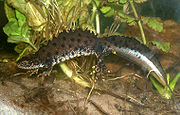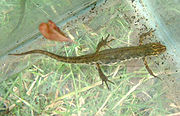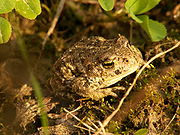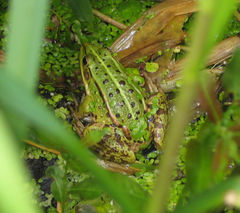
List of British amphibians
Encyclopedia
This is a list of the amphibians of Great Britain. There are seven amphibian
species native to Great Britain, in addition, there are a number of naturalized species. The natives comprise three newts, two toads and two frogs.
Naturalised
Amphibian
Amphibians , are a class of vertebrate animals including animals such as toads, frogs, caecilians, and salamanders. They are characterized as non-amniote ectothermic tetrapods...
species native to Great Britain, in addition, there are a number of naturalized species. The natives comprise three newts, two toads and two frogs.
Native species
| Common name | Species (Authority) |
Preferred habitat | Native range | Status and estimated breeding adult population | |
|---|---|---|---|---|---|
| Subfamily Pleurodelinae: Newts | |||||
| Great Crested Newt Great Crested Newt The Great Crested Newt, also called Northern Crested Newt or Warty Newt is a newt in the family Salamandridae, found across Europe and parts of Asia.-Distribution:...  |
Triturus cristatus (Laurenti, 1768) |
Terrestrial habitats with dense cover, usually within about 200 metres of the breeding pond | UK population found only in England, Wales and Scotland. |
360,000 |
|
| Smooth Newt Smooth Newt The Smooth Newt, also known as the Common Newt, Lissotriton vulgaris is the most common newt species of the Lissotriton genus of amphibians. L...  |
Triturus vulgaris (Linnaeus, 1758) |
Terrestrial habitat, lay eggs in ponds and shallow lakesides | UK |
13,700,000 |
|
| Palmate Newt Palmate Newt The Palmate Newt is a species of newt found in most of Western Europe, including Great Britain. It is protected by law in all countries where it occurs, and is thought to be extremely rare to endangered in the Netherlands, Belgium and Luxembourg and vulnerable in Spain and Poland but common... .jpg) |
Triturus helveticus (Razoumowsky, 1789) |
Marshland, ponds and lakesides | Great Britain except areas of South East |
1,800,000 |
|
| Family Bufonidae: Toads | |||||
| Common Toad Common Toad The common toad or European toad is an amphibian widespread throughout Europe, with the exception of Iceland, Ireland and some Mediterranean islands... .jpg) |
Bufo bufo (Linnaeus, 1758) |
Deciduous woodland, scrub, gardens, parks and fields, more aquatic during breeding season | Great Britain |
5,900,000 |
|
| Natterjack Toad Natterjack Toad The Natterjack Toad is a toad native to sandy and heathland areas of Europe. Adults are 60–70 mm in length and are distinguished from Common Toads by a yellow line down the middle of the back...  |
Bufo calamita (Laurenti, 1768) |
Open and unshaded light sandy soils | Scattered parts of England and Scotland |
20,000 |
|
| Order Anura: Frogs | |||||
| Common Frog Common Frog The Common Frog, Rana temporaria also known as the European Common Frog or European Common Brown Frog is found throughout much of Europe as far north as well north of the Arctic Circle in Scandinavia and as far east as the Urals, except for most of Iberia, southern Italy, and the southern Balkans... .jpg) |
Rana temporaria (Linnaeus, 1758) |
Hibernate in semi-aquatic areas, migrate to water to breed | UK |
16,000,000 |
|
| Pool Frog Pool Frog The Pool Frog is a European frog. It is one of only four amphibian species recognized by the UK government as protected under its Biodiversity Action Plan. The reasons for declining populations are decreased pond habitat from human encroachment and also air pollution leading to...  |
Pelophylax lessonae (Camerano, 1882) |
Terrestrial-aquatic borders | Thought to be native to Norfolk |
|
|
NaturalisedNaturalisation (biology)In biology, naturalisation is any process by which a non-native organism spreads into the wild and its reproduction is sufficient to maintain its population. Such populations are said to be naturalised....
and escaped species
- SalamanderSalamanderSalamander is a common name of approximately 500 species of amphibians. They are typically characterized by a superficially lizard-like appearance, with their slender bodies, short noses, and long tails. All known fossils and extinct species fall under the order Caudata, while sometimes the extant...
s and Newts- Fire SalamanderFire SalamanderThe fire salamander is probably the best-known salamander species in Europe. It is black with yellow spots or stripes to a varying degree; some specimens can be nearly completely black while on others the yellow is dominant. Shades of red and orange may sometimes appear, either replacing or mixing...
(Salamandra salamandra) — has bred at least once - Alpine NewtAlpine NewtThe Alpine Newt is a newt of the Salamander order Caudata in the class of Amphibians.-Description:...
(Triturus alpestris) (naturalized) - Italian Crested NewtGreat Crested NewtThe Great Crested Newt, also called Northern Crested Newt or Warty Newt is a newt in the family Salamandridae, found across Europe and parts of Asia.-Distribution:...
(Triturus (cristatus) carnifex)
- Fire Salamander
- Toads
- Midwife ToadMidwife toadMidwife toads are a genus of frogs in the Discoglossidae family, and are found in most of Europe and northwestern Africa. Characteristic of these toad-like frogs is their parental care: the males carry a string of fertilised eggs on their back, hence the name "midwife". The female expels a strand...
(Alytes obstetricans) (naturalized) - Yellow-bellied ToadYellow-bellied toadThe Yellow-Bellied Toad belongs to the order of Anura, the archaeobatrachial family of Bombinatoridae, and to the genus of fire-bellied toads.- Anatomy :...
(Bombina variegata) (naturalized)
- Midwife Toad
- Frogs
- Painted FrogPainted FrogPainted Frog may refer to:*Atelopus ebenoides – from Central America*Discoglossus pictus – from the central Mediterranean region.*Neobatrachus pictus – from southern Australia*Neobatrachus sudelli – from eastern Australia...
(Discoglossus pictus) — has bred at least once - European Tree FrogEuropean tree frogThe European tree frog is the common name of Hyla arborea. The original name of this frog was Rana arborea. Some of the other common names include:*Rainette verte *Laubfrosch *Ranita de San Antonio...
(Hyla arborea) - Australian Tree Frog — has bred at least once
- Marsh FrogMarsh FrogThe Marsh Frog is the largest frog native to Europe and belongs to the family of true frogs. It is very similar in appearance to the closely related Edible Frog and Pool Frog...
(Rana ridibunda) (naturalized) - Edible FrogEdible FrogThe Edible Frog is a name for a common European frog, also known as the common water frog or green frog . It is used for food, particularly in France for the delicacy frog legs...
(Rana esculenta) (naturalized) - American Bullfrog (Rana catesbeiana) — not established
- African Clawed Frog (Toad)XenopusXenopus is a genus of highly aquatic frogs native to Sub-Saharan Africa. There are 19 species in the Xenopus genus...
(Xenopus)
- Painted Frog

